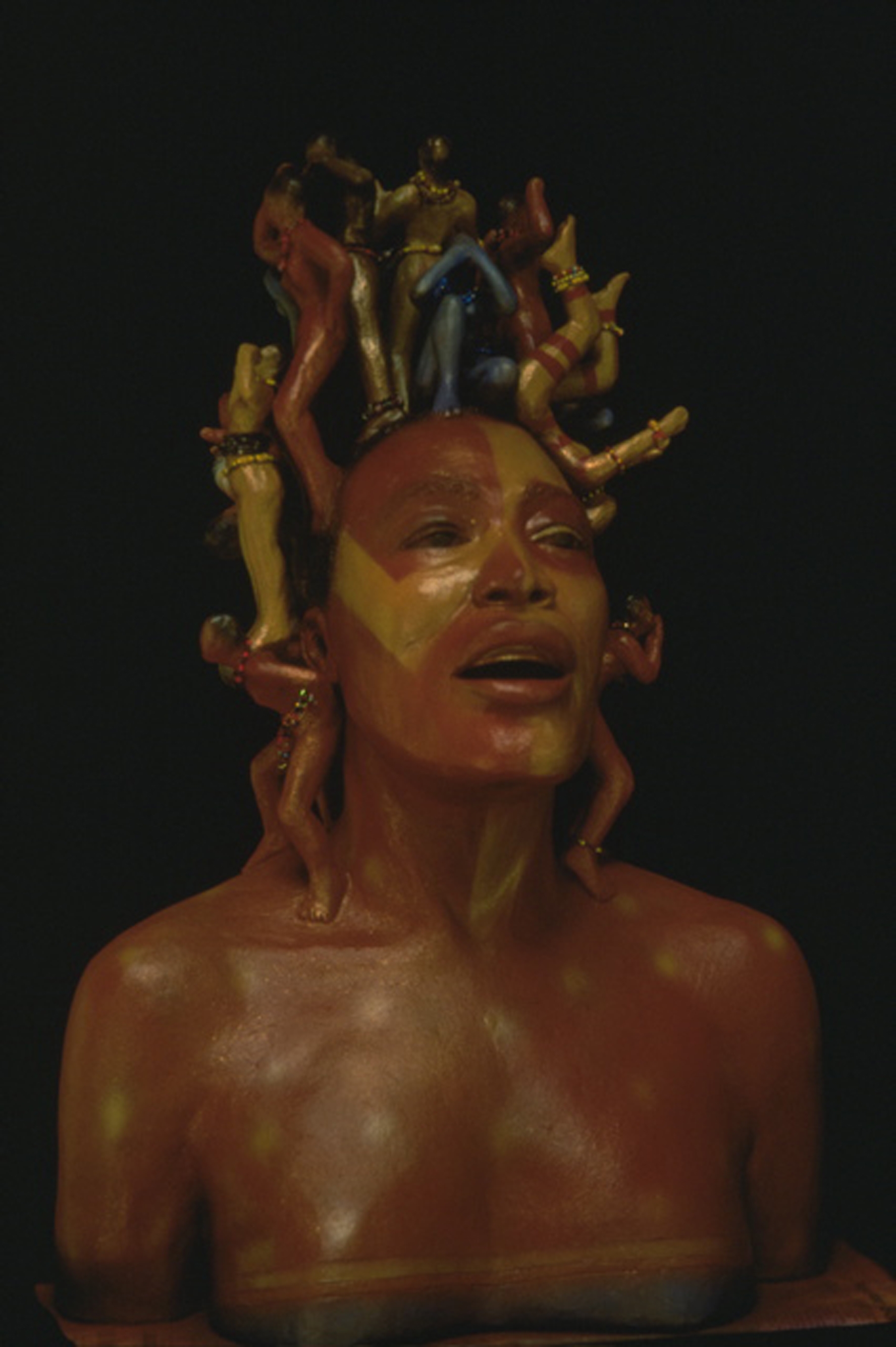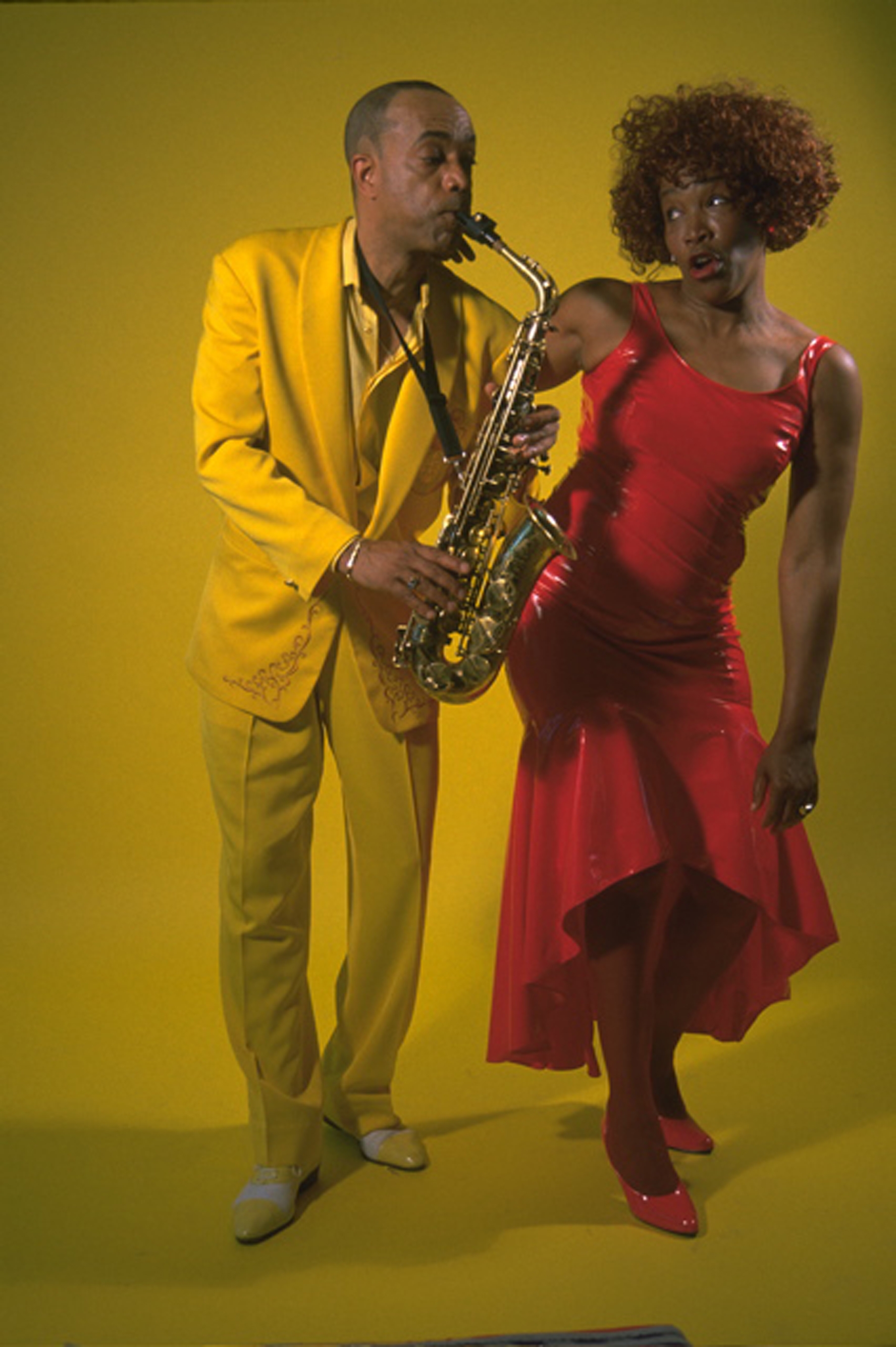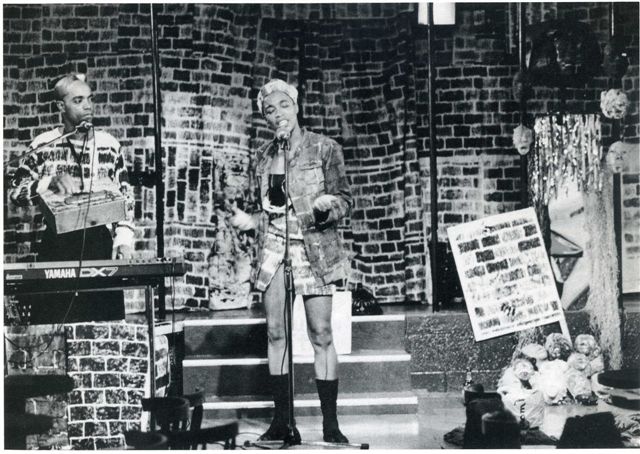| AN INTERVIEW WITH CULTURAL ODYSSEY |
JANUARY 25, 2009
Special for THE NEW TIMES HOLLER!
© Amir Bey, 2007
|
From January 29 through February 7, IDRIS ACKAMOOR and RHODESSA JONES will be performing THE LOVE PROJECT at LaMama E.T.C. in New York City. photo by Pat Mazzera
RHODESSA JONES in Imagining Medea
IDRIS ACKAMOOR and RHODESSA JONES
IDRIS ACKAMOOR and RHODESSA JONES in Meditations on Modern Life, 1986, set design, Amir Bey, photo by William Goidell
THE NEW TIMES HOLLER! INTERVIEWS CULTURAL ODYSSEY CO-ARTISTIC DIRECTORS IDRIS ACKAMOOR AND RHODESSA JONES
© Amir Bey, 2009
HOLLER!: What are the origins of Cultural Odyssey?
IDRIS: I founded Cultural Odyssey in 1979. The actual legal name of the company is Idris Ackamoor & Cultural Odyssey. One of the reasons I had my name out front was the fact that I was one of the Co-founders of the trend setting avant-garde jazz and world music group The Pyramids. The Pyramids was a family band in many ways and we accomplished a great deal as one of the first bands of our kind. When The Pyramids broke up the name basically went with the break up. This meant that all of the work and effort into building name recognition for the band went down the tubes since no single member could claim the name and push on.
When I founded Cultural Odyssey, I wanted to make sure this situation did not occur again and that no matter what my name was perpetually associated with the company as the founder. However, almost since the beginning Idris Ackamoor & Cultural Odyssey was shortened to Cultural Odyssey. This particularly made sense regarding the long term relationship that Rhodessa and myself have had and the fact that in every sense of the word the success and visibility of the company can be attributed to both of our efforts over most of the 30 year existence of the company. We are a team and Co-directors of the company.
After The Pyramids broke up in 1977 I spent time learning my craft forming and leading different jazz quartets and quintets performing around the Bay Area. Dealing with the "jazz drag" of low paying gigs, late and uncooperative musicians, and constantly changing personnel I grew increasing frustrated with the "jazz musician thang". I decided to reach way down within myself and go solo! Going solo meant no longer having to deal with late musicians and/or uncooperative ones. However, it also meant that I had to mine the rich interdisciplinary nature of performance inspired by what I learned during my travels throughout Africa with The Pyramids. I developed a one-man show entitled, "The Beginning of the Second Earth" that utilized poetry, costumes, slides, pre-recorded tapes and theater. It was at one of the first performances of the show at the Savoy Theater in San Francisco's North Beach that I met Rhodessa Jones.
On a chilly, brisk 1979 night in San Francisco's North Beach, the Savoy Tivoli Club was the site of an exciting performance art double-bill. The Beginning of the Second Earth was the very first production of my fledgling performance company, Cultural Odyssey, featuring myself. The other half of the bill featured a wild wacky performance by, Rhodessa Jones, and musician Harry Mann and Neal Kirkwood in an adaptation of Toni Cade Bambara's, Gorilla, My Love. This was the first time I met Rhodessa - in the theater! I was very moved by her performance. That was also one of the first times I saw a performer move, speak, and sing in a very "experimental" manner. I was convinced that I had to find out more about this talented lady! Following this fateful meeting, we began a dialogue about art, life, and dreams.
At that time in 1979, Rhodessa's house was a gathering place for artists, gays, and other "in the life" characters. I began showing up and participating in artistic soirees and conversational potpourris. She was also fascinated and impressed by the artistic concept I had for Cultural Odyssey. In those early years I was a jazz visionary who had gone on a pilgrimage to Africa and returned with not only a new spiritual awakening, but also a love for interdisciplinary performance. I was set upon a path to combine the art forms of music, dance and theater into a unified whole. My time spent in Africa inspired my early development. I was awed by how African art was informed with a merging of the spirit...the flowing of the various art forms into one.
Sometime after my solo performance I added a dancer and actress and once again a jazz quartet, and thus the Cultural Odyssey Ensemble was born. One of our first major performances in San Francisco was an expanded version of my solo work, The Beginning of the Second Earth. In 1979, the Eureka theater produced a Midnight Series featuring some of the most ambitious and experimental new performance artists in San Francisco such as Bill Talen, Winston Tong, and yes, Rhodessa Jones in The Legend of Lily Overstreet, and Idris Ackamoor and Cultural Odyssey in The Beginning Of the Second Earth. Rhodessa and my performances were back to back, with Cultural Odyssey following a mad hit run of Lilly Overstreet. The town was crazy for Lilly! At the same time Cultural Odyssey continued to hone its artistic vision.
HOLLER!: Rhodessa, your family background is interesting from the creative standpoint; how did it shape you as an artist?
RHODESSA: My father was a migrant crew leader. We moved up and down the eastern seaboard- picking fruits and vegetables from Florida all the way to New Jersey. We would return to our home in Florida for the winter. As migrants we were relegated to the countryside living in tractors barns, makeshift shelters to abandoned farmhouses. We were the real outsiders! We were America’s gypsies! It was an experiment in displacement. It gave me a bird’s eye view of the world.
I brought this into my life as an artist. I was always speaking for the true “otherness” in America.
HOLLER!: Cultural Odyssey incorporates many kinds of performance: dance, music, comedy, drama. At what point did the activism, which seems to propel you all over the globe, enter?
RHODESSA: I think activism has been inherent in my voice, my body and my perception of this American life. Finding my personal voice in a culture that has discovered multiculturalism signals a revealing of the things that spoke to the reality of being an outsider; the invisible woman. I simply added that seasoning to Cultural Odyssey’s multidisciplinary performance.
HOLLER!: In your view do you see all art as political, or that is should be?
RHODESSA: The art that can speak to us all is organically political. The universality of performance has to be political, which is inclusive without trying.
HOLLER!: In the last few years you’ve done residencies in Trinidad and South Africa; what similarities and differences did you find between those places?
RHODESSA: I truly enjoyed teaching in both places where the population looks like me. It has been rich in the reality that our struggles reflect our experiences on the planet in the known world! I was struck by national identity in both places. The connection with place was enlightening. In South Africa the folks are always navigating many languages and dialects to communicate with each other! In Trinidad, I went to a shrine for the birthday of Oshun, the goddess of creativity. The ceremony was sacred, powerful with a closely guarded and respected mysticism!
HOLLER!: What were the projects and activities were you engaged in there?
The residency in Trinidad was rooted in community. We went to community centers where we were asked to help them find ways to guide their youth away from crime. The participants spoke of the love for the community. They asked us to give them tools to ground the family with purpose and commitment. In South Africa we offered workshops to the communities. The workshops were rooted in ways to be working artists, i.e. creating, performing and producing art. We worked in the prisons with female inmates- helping them to give voice to their lives inside and outside of the prison, it culminated in a performance entitled: Serious Fun at Sun City.
HOLLER!: Much has been said about South Africa’s AIDS situation, the corruption, and the ongoing poverty in nation that potentially could be one of the foremost nations in Africa technologically and economically. What did you see?
RHODESSA: I was fortunate to be in the “belly of the beast” with women who are living with HIV. They volunteered information about their status. There was a general consensus that we are either infected or affected. One young woman who was recently diagnosed was very open about the toxicity of her treatment. She had to be excused often because of her trips to hospital. I found very forward thinking about the virus. There was much discussion about opening orphanages for children with HIV.
HOLLER!: What is the Medea Project Theater for Incarcerated Women:? Did it grow out of Big Butt Girls and Hard Headed Women?
RHODESSA: Yes, after the success of Big Butt Girls I knew that I had to find a way for female offenders to tell their personal stories. The Medea Project is a theatre workshop design to encourage the female prisoner to examine her participation in her in her incarceration. The project is a performance workshop that utilizes theatrical devices such as storytelling, movement, vocalizing, and journaling to create autobiographical theatre.
HOLLER!: You are based in San Francisco. Tell us about the African American Art & Culture Complex; when I visited there in 2007 I was impressed with the amount of programs and venues in one place! What y’all doin’ there?
IDRIS: The African American Art & Culture Complex is a city owned cultural center. In the 1970's the city officials decided to endow each major San Francisco neighborhood with a center thus the name "Neighborhood Cultural Centers". Over the years the Complex had suffered from a variety of administrations that were very unorganized and corrupt. Presently the Complex is a successfully administered, maintained and functioning cultural center. However, as is the tendency with cultural centers intended to serve the community there is a schism between "community" and "professional". Navigating between these two is a tricky and difficult process. This is predominately felt in the Artistic vision which to date continues to be one of my biggest disappointments with the state of the Complex.
However, Cultural Odyssey is one of the longest residents at the Complex, and it is a blessing to have rehearsal and office space at very low rates. For over twenty years we have conducted programs as well as housed our offices there. In reality we are a nomadic company in terms of our artistic programs preferring to collaborate and partner with a variety of professional theater venues in San Francisco.
HOLLER!: Looking at the many awards Cultural Odyssey has received, the amount of projects that you are engaged in, it can be said that you are successful. Let’s talk about the struggles involved in putting this together, what kinds of challenges have you faced? Do you see problems mounting with the economic situation as it is now?
IDRIS: Cultural Odyssey has indeed been fortunate regarding awards and funding. However, there were many struggles associated with maintaining, continuing, and prospering a non-profit arts company over 30 years. One of the main reasons for the success of the company has to do with our longevity. The company was formed at a very opportune time in terms of the funding climate. Many of the nation’s foundations and government funding agencies were in their first decade of navigating and setting funding policy and planning. The National Endowment for the Arts was still in the business of funding individual artists in the early and mid eighties. They were also just beginning programs targeting community organizations and organizations of color in their "Expansion Arts Program". Equally, the California Arts Council was just coming on line and their budget was steadily growing. Cultural Odyssey was able to take advantage of this very "funding friendly" climate to begin receiving our first grants and awards. They were very small at first; however, they increased in regularity and size as we became more visible and effective in our programming. It was also incredibly helpful that we were not a one-discipline organization. In fact, we were multi-disciplinary and interdisciplinary. We could receive funding as a music organization, a theater organization, a presenter, or a community involved organization. Once Rhodessa birthed The Medea Project: Theater for Incarcerated Women in 1989-90 a whole new funding stream was activated for Cultural Odyssey.
Some of our challenges were, and continue to be, obstacles that many organizations of color have to face; particularly African American ones. Private Foundations were and continue to be one of the hardest ceilings to break through. In the past they have not had a lot of incentive to reach out to African American organizations and provide equitable streams of support that Euro-centric organizations have routinely received. This is slowly changing with new initiatives. Of course with the present state of the economy funding challenges will also accelerate and negatively affect all arts organizations. However, it is my feeling that the African American organizations will be particularly hard hit.
Of course one of the biggest challenges the company had to face was when Rhodessa and I ceased to be a romantic couple and making the transition to life and business partners. As I say in one of my monologues in The Love Project:
“How does one make that transition from sleeping together to life partners? Well, it ain’t easy, but we both are better for it that’s for sure. The tendency when you split up is to part mad, angry; don’t want nothin’ or anything to do with that person. Well, that might make you feel good for a minute, but it would have left me alone for a lifetime without my best friend. We didn’t choose that route. Instead we chose to learn how to hold on to the parts that work. "
HOLLER!: How do you see the “climate” for the arts and artists in general in the US?
IDRIS: One of the biggest challenges that many arts organizations will face in the coming years will be to develop alternative ways of operations. The concept of "business as usual' will no longer be an effective way of running an organization. New modes of thought and new organizational structures will have to be explored and employed if many organizations are to continue to exist and hopefully prosper. Hard difficult decisions will have to be made and strategic alliances developed on a global scale.
HOLLER!: From January 29 through February 7, you’ll be performing THE LOVE PROJECT at La MaMa E.T.C. in New York City. It’s been described as “part house party, part TV talk show and part cabaret”; tell us about it.
RHODESSA: The Love Project is an evening of renewed hope, disguised as cabaret, house party, etc. When we began to create the show I was not aware that it was a living prayer for change! Lo and behold along comes Barack Obama. In the words of Maya Angelou: We called out and he came! The Love Project is a public forum to encourage us, the people, to step up our game as we peruse love-Love of community, family, country and neighbor. I see it as a very lively town-hall meeting! I hope everyone will come out and be a part of this offering in the name of honoring us, the human family!
|
|




